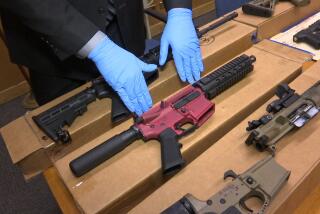Taming the Gun Monster: How Far to Go? : Why half-measures, though well-intentioned, can’t roll back the epidemic that’s unnerving, and killing, America
- Share via
How awful is the American gun-violence epidemic? Just look around--you know how bad it is. Every day 14 American children are killed by guns. Every six hours a youth uses a gun to commit suicide. Nearly every 30 minutes someone is murdered with a firearm. So let’s be honest: Although a lot of law-abiding, patriotic Americans own firearms and never once have used them unsafely or illegally, it’s absolutely clear that as a society the United States just can’t handle guns. Guns and public safety do not mix, and more denial won’t get us anywhere. So what is to be done?
Readers of Part 1 of this series know that The Times comes down on the side of a near-total ban on handguns and assault weapons that exempts only law enforcement and permits ownership of sporting and hunting weapons under certain conditions. Many might ask: Couldn’t there be some sensible intermediate steps? Such steps are possible, but they wouldn’t do the job. Nearly every state now has laws restricting the sale or use of firearms. The federal government began to restrict weapons use and trade in the 1930s. Congress has since passed other gun legislation and is now debating the Brady bill, which would require background checks on handgun purchasers, along with about 40 other bills. Yet existing state and federal laws and local ordinances have utterly failed to stop the dramatic escalation of gun violence. These laws still permit an enormous supply of firearms. And frightened people keep buying weapons, stimulating the manufacture and sale of even more firearms. Because of legal loopholes and poor enforcement, firearms have fallen into the hands of children, criminals and those with a record of mental instability.
Even so, reasonable people sincerely disagree on the best approach. Some argue strongly that imposition of a national waiting period to permit a background check on handgun buyers would keep guns away from criminals. Others believe that limits on the sale of ammunition would help. But although useful, none of these measures, even taken together, would stop the killing: The problem is the towering weapons stockpile that already exists, and the relentless production and sale of new guns. Here is a closer look at some worthy but lesser measures:
1. ENFORCE EXISTING LAWS BETTER: The federal government, most states and many local communities already have the power to tax, license and restrict the manufacture, sale and importation of specified types of weapons. These laws establish waiting periods between purchase and delivery of a firearm, mandate background checks on gun purchasers, require registration or licensing, mandate safety training, restrict sales of certain types of ammunition and ban the manufacture or sale of certain types of assault weapons.
But the laws themselves have gaping loopholes--for instance, when a specific model of gun is banned, manufacturers just change some details to in effect make it legal again--and the agencies delegated to enforce these laws are understaffed and underfunded. Pending proposals to beef up enforcement and close loopholes are wise but would do nothing to reduce the huge stockpile of weapons and very little to stem production and sale totaling 2 million to 4 million new ones yearly. So they would do little to stop the killing.
2. GET TOUGH ON GUN CRIME: Would more severe punishments for crimes committed with guns help? Perhaps. But even as state and federal penal codes have ratcheted up such penalties--for murder or carjacking, for example--the incidence of gun violence has skyrocketed. Tough laws can only deter criminals when they are firmly and consistently enforced. Yet as budget cuts have hit police departments, district attorneys’ offices and prisons, gun-related crimes increasingly go unsolved and unpunished. Those convicted and sentenced to prison for gun crimes are too often granted early release because of overflowing jails.
3. MAKE GUNS SAFER: The federal government estimates that 1.2 million elementary-school-age, latchkey children have access to guns in the home. Tragically, many of them shoot themselves or their young friends in accidents: Guns constitute the third leading cause of accidental death for children. Yet the federal government is prohibited from regulating the design or size of guns. Closing this loophole could help avoid more tragedy.
But how would it help if we did make guns safer and harder for kids to discharge? Accidental shootings involving new guns should drop, but nothing else. Most likely, safety regulations would not affect the 200 million weapons in circulation. And such regulations would do absolutely nothing to reduce premeditated gun crime.
4. TRACK GUNS AND GUN OWNERS: Individuals convicted of a felony or those with a history of mental instability are already prohibited from buying or possessing firearms by federal law and in most states. California law imposes a 15-day waiting period on purchasers prior to delivery of the gun to allow for a state background check. But in many states, the declarations of would-be gun purchasers as to their criminal or psychological history are not verified. As a result, many who legally cannot own a gun do. The Brady bill, now pending for 6 1/2 years in Congress, would require local authorities to conduct a background check within five working days on all would-be handgun purchasers prior to possession.
The Brady bill should pass. It would help keep some new weapons out of some wrong hands. But no waiting period, however long, and no background check, however thorough, can keep guns that are lawfully purchased from being stolen by those not allowed to own one. No waiting-period law is likely to affect the owners, legal or not, of the many guns already out there.
The very same weaknesses would undermine a system that tracks guns, not their owners. Every gun could carry an identification number, allowing authorities to trace it from manufacture through purchase and each subsequent transfer, like a car. A good idea, perhaps. But, again, such a system would not reach the huge numbers of stolen weapons now in circulation.
5. RESTRICT AMMUNITION: America now has a 200-year supply of guns but only a four-year supply of bullets. These estimates suggest that limits on ammunition may be easier to achieve than restrictions on firearms.
Some cities, states and the federal government already ban some types of ammunition, such as armor-piercing Teflon bullets or the so-called flaming or exploding bullets. This is sensible, but no substitute for comprehensive weapons restrictions. The problems inherent in limiting bullet production and sales are similar to those that plague the half-way schemes to control gun distribution. The fewer the bullets, the higher the price for existing stocks, and the larger the financial incentive for an underground market. The gun supply would fuel that demand for bullets: The problem is the guns.
So what’s left? All these sensible, intermediate proposals to reduce gun violence are supported by individuals who sincerely want the violence and the killing to stop. The proposals may help deter some criminals from acquiring some guns or protect some children from accidental shootings. Yet because none even begins to reduce the frightful stockpile of weapons in this country or slow the production of new guns, none would succeed in returning sanity to our lives and peace to our streets.
Only a near-total federal ban on the production and sale of handguns and assault weapons would do that. That is The Times’ position and the recommendation that we will be making again and again. Many reasonable people, of course, will disagree with us, will argue either that the Constitution absolutely guarantees them the right to bear arms or that somehow all these guns actually make society safer. But common sense--and cruel experience--tell us otherwise. We can only hope that our political leaders in Washington will get the message before it is too late.


